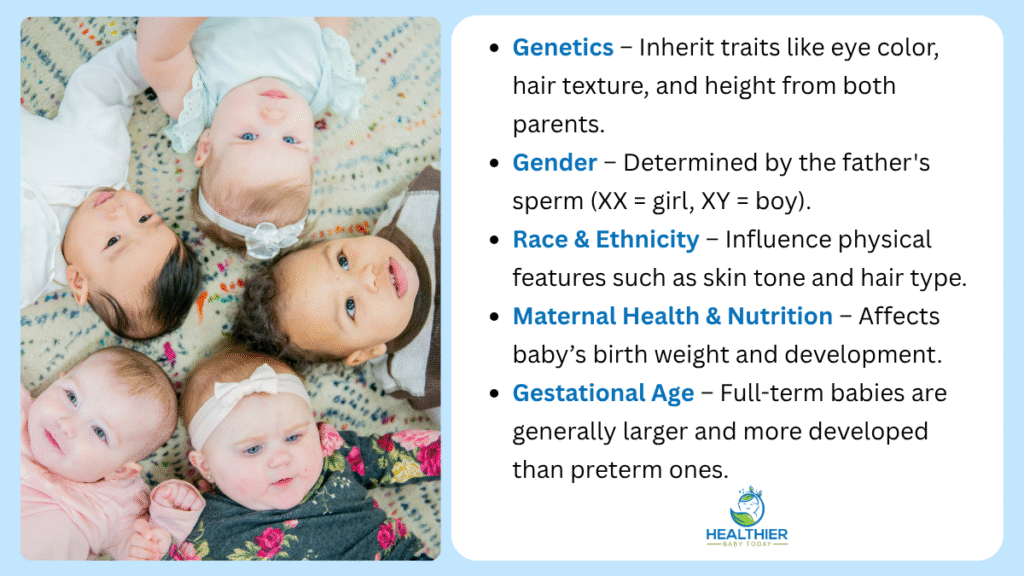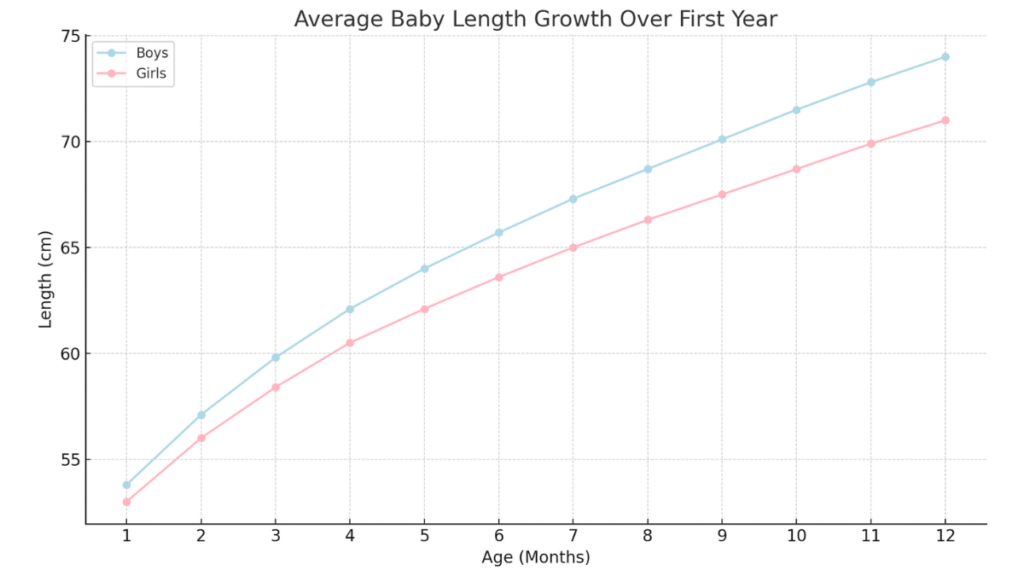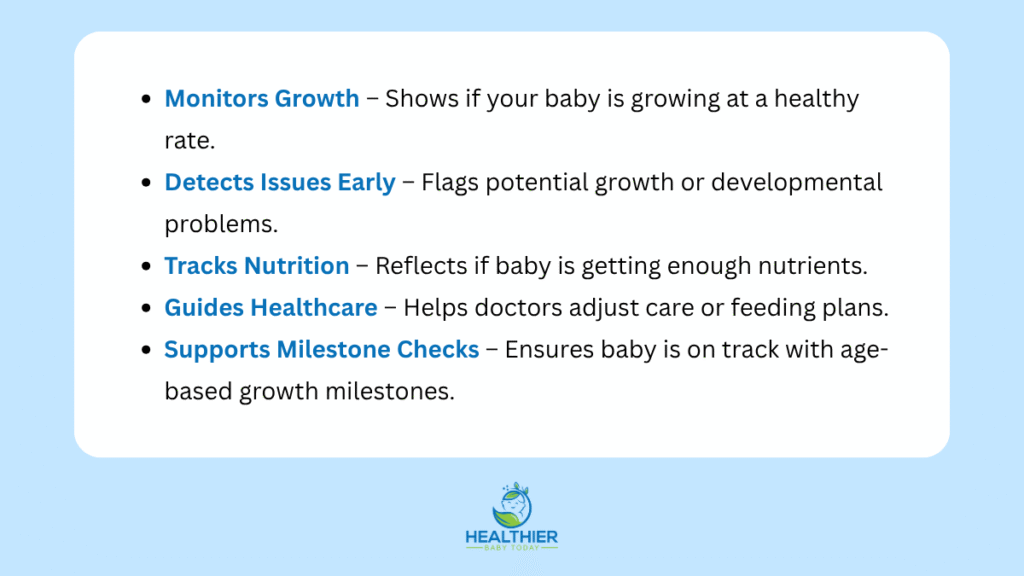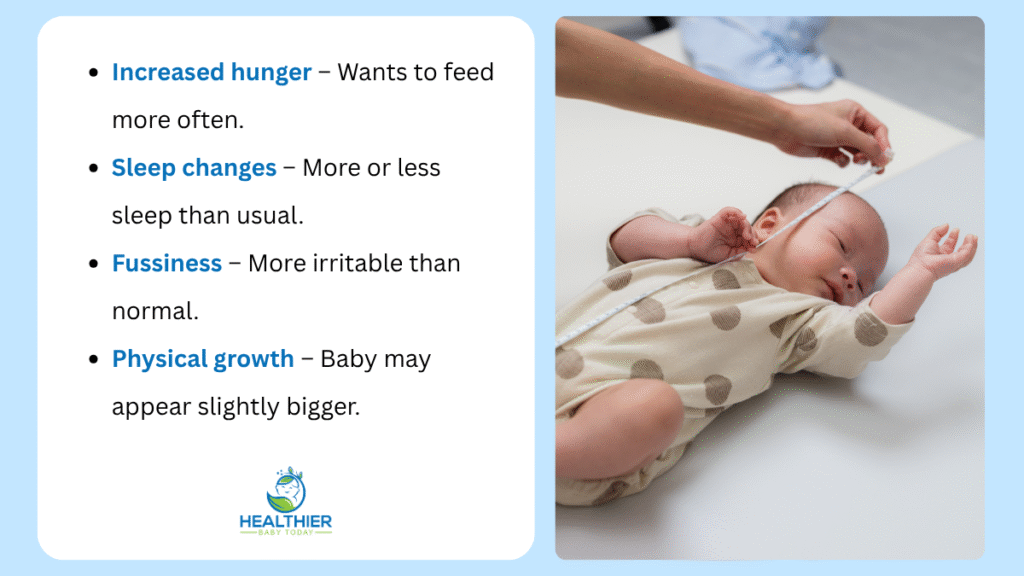A baby’s length is determined by measuring from the top of their head to the bottom of one heel. This is similar to measuring height when the baby is standing, while length is measured when they lie flat. So, what is the average length of a newborn baby? A full-term baby is typically about 19 to 20 inches long (around 50 cm) at birth. Most newborns usually fall within a range of 18 to 22 inches (45.7 to 60 cm).
The typical newborn length is about 18 to 22 inches, but it’s important to remember that each baby is unique. While length is a key factor, other aspects like birth weight and how the baby grows after birth are also significant.
This article discusses everything about a newborn length and more!
Table of Contents
Average Size Chart Of A Baby’s First Year

According to the World Health Organization’s (WHO) growth chart, the typical newborn length for male and female babies is as follows:
| Age | Male Baby | Female Baby |
| Birth | 19.69 in | 19.29 in |
| 1 Month | 21.65 in | 21.26 in |
| 2 Months | 23.03 in | 22.44 in |
| 3 Months | 24.21 in | 23.62 in |
| 4 Months | 25.20 in | 24.41 in |
| 5 Months | 25.98 in | 25.20 in |
| 6 Months | 26.77 in | 25.48 in |
| 7 Months | 27.17 in | 26.38 in |
| 8 Months | 27.95 in | 27.17 in |
| 9 Months | 28.35 in | 27.56 in |
| 10 Months | 28.74 in | 28.15 in |
| 11 Months | 29.33 in | 28.74 in |
| 12 Months | 29.92 in | 29.13 in |
Newborn Length in Premature Babies
Premature babies get measured and weighed often, just like babies who are born on time. However, doctors might use “adjusted age” to track these babies’ growth. For instance, if your baby is 16 weeks old but was born 4 weeks early, the doctor will take away those 4 weeks.
The adjusted age would be 12 weeks. This means your baby should be reaching the growth and development milestones for a 12-week-old. By the time they are 2 years old or even earlier, most premature babies usually catch up to their friends, and the doctor won’t need to adjust their age anymore.
What Your Baby’s Size Means
Babies smaller or bigger than the normal length of a baby at birth are more likely to experience health issues, but this will likely not be visible immediately. A tall adult might’ve been short as a baby, but many factors can affect newborn length.
Such as the following:
- Parents’ size: If parents are tall and big, their newborns might be more significant than usual. On the other hand, if parents are short and small, their babies might be smaller than the average length of a newborn.
- Multiple births: The babies are usually smaller when having twins, triplets, or more. This is because they have to share space in the womb and often arrive a little early, making them smaller at birth.
- Birth order: The first baby in a family is sometimes smaller than the siblings that come after.
- Gender: Generally, girls are smaller than boys, but the difference in size at birth is not very big.
- Mom’s health during pregnancy: If a mother has health issues like high blood pressure or heart problems, or if she smokes, drinks alcohol, or uses drugs, it can lead to a lower birth weight. Conversely, if a mother has diabetes or is overweight, her baby might be bigger.
- Nutrition during pregnancy: Eating well is vital for a baby’s growth before and after birth. If a mother has a poor diet during pregnancy, it can affect the baby’s weight and growth. Gaining a lot of weight can also make it more likely for the baby to be born larger than average.
- Baby’s health: Specific medical issues, including birth defects and infections during pregnancy, can impact a baby’s birth weight and growth later.
How Your Baby Will Grow In Their First Year?

Healthy babies come in all sorts of sizes. On average, most babies will have tripled their birth weight by their first birthday. Their heads usually grow about 4 to 5 inches (10 to 13 centimeters) during that time, and they typically get around 9.5 inches (24 centimeters) taller in their first year. However, a baby’s growth isn’t steady; it happens in bursts. What babies eat significantly affects how quickly they grow, and their genes also influence their growth patterns.
Here are some general guidelines for a baby’s growth during the first year:
- Weight: Babies usually gain weight quickly, then it slows down. In the first few months, they gain about 1 ounce (28 grams) daily. By around 4 months, this slows to about 20 grams a day; by 6 months, many babies gain about 10 grams or even less daily.
- Height: From birth to about 6 months, babies grow roughly 1 inch (2.5 centimeters) each month. After that, from 7 to 12 months, they might grow about half an inch (1.3 centimeters) each month.
- Head size: Measuring a baby’s head helps track brain growth. In the first month, a baby’s head might grow about 1 inch (2.5 centimeters), but on average, it grows about 0.4 inches (1 centimeter) each month after that.
Why Is It Important To Track Newborn Length?

Your pediatrician will check how long your baby is at every visit. This measurement is essential, but your doctor cares most about whether your baby gains weight each month. By the time babies are 5 months old, they should weigh twice as much as they did at birth, and by their first birthday, they should weigh three times their birth weight.
Keep in mind that babies have growth spurts. It’s not as crucial to focus on how much they grow each month, but rather the overall trend on their growth chart. If your baby isn’t growing or their growth slows down during the first year, your doctor might send you to a specialist. An endocrinologist could do blood tests, X-rays, or scans of the body or brain to determine why your baby isn’t growing.
In rare situations, your doctor might want to check for:
- Hypothyroidism
- Growth hormone deficiency
- Turner syndrome
What Should I Do When I’m Concerned About My Baby’s Health?
If you’re worried your child isn’t eating enough, reaching their developmental milestones, or meeting newborn average length numbers, it’s a good idea to talk to your pediatrician. You can tell if your baby is eating enough by checking their diapers.
A newborn should have about two to three wet diapers daily. After the first four to five days, they should have around five to six wet diapers daily. How often they poop can vary depending on whether they’re breastfed or formula-fed. If your baby grows well at each checkup, they are probably getting enough food. If you have any concerns, don’t hesitate to contact your pediatrician.
How Often Should Your Baby Eat?
Every baby is unique, but here are some essential tips on how much and how often your baby should be fed:
| Age | Feeding Frequency | Amount of Breastmilk/Formula per Feeding |
| Newborn | Every 2 to 3 hours | 1 to 2 ounces |
| 2 weeks | Every 2 to 3 hours | 2 to 3 ounces |
| 2 months | Every 3 to 4 hours | 4 to 5 ounces |
| 4 months | Every 3 to 4 hours | 4 to 6 ounces |
| 6 months | Every 4 to 5 hours | Up to 8 ounces |
Starting solid foods is usually a good idea between 6 and 8 months, but if your baby seems ready, your doctor might suggest starting earlier. After you begin giving solids, keep giving breastmilk or formula until your baby turns 1 year old.
Feeding frequency charts can help, but they are a suggestion. The best time to feed your baby is when they are hungry. Unless your pediatrician tells you otherwise, don’t hold back food or make your baby eat if they don’t want to.
How to Identify Growth Spurts

A growth spurt can happen at different ages. Still, it usually occurs when a baby is about two to three weeks old, around six weeks, and again at three months, according to the American Academy of Pediatrics (AAP). During these times, babies often want to nurse a lot.
If breastfeeding, the AAP suggests that you stick to breast milk for the first six months since that’s all your baby needs. Growth spurts also typically happen at six and nine months, when you can start introducing other liquids and foods. Besides being extra hungry, you might notice your baby is fussier and waking up more at night during a growth spurt.
Conclusion: A Summary
The weight and length of your baby are significant for their doctor because these measurements help them see if your baby is growing correctly. However, it’s best not to obsess over the numbers or compare your baby to others.
Babies come in all shapes and sizes and have a wide range of the average length of a newborn baby. The important thing is that your baby continues to grow steadily based on their growth history. If there are any changes, your baby’s doctor will help you get everything back to normal.
FAQs
Is 57cm Long For A Newborn?
Yes, 57cm is a bit tall for a newborn, as doctors consider a range of 47–53 cm normal.
Do Short Babies Turn Into Short Adults?
No, short babies don’t always turn into small-built people.
How Do I Tell If My Baby Will Be Tall?
You can estimate your child’s adult height by adding both parents’ heights based on their genetics. Add 5 inches for a male baby’s newborn length or deduct 5 inches for a female baby, then divide that number by two.
Can Two Short Parents Have A Tall Baby?
Yes, short parents can also give birth to tall babies.
What Month Does My Baby’s Height Increase?
Usually, babies grow 0.5 to 1 inch each month from birth to 6 months. From 6 to 12 months, babies grow an average of 3/8 inch per month.


